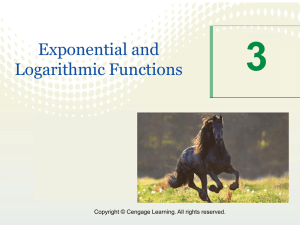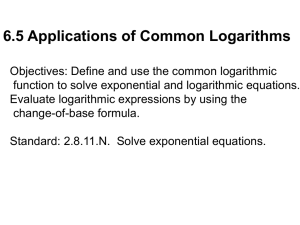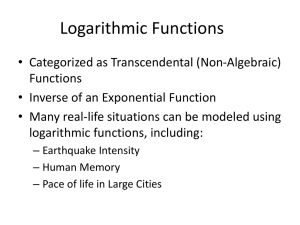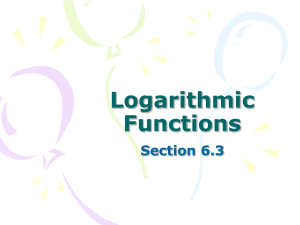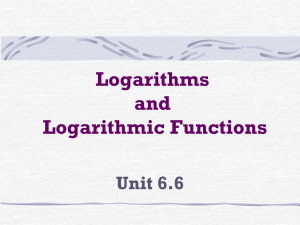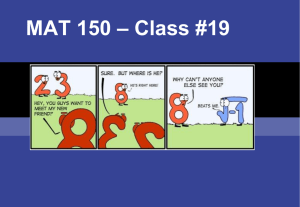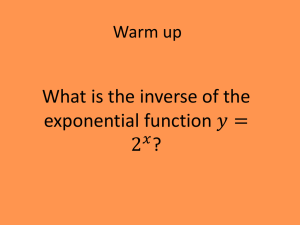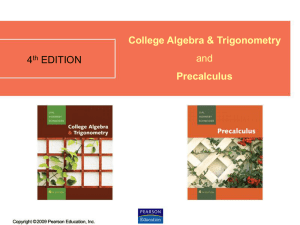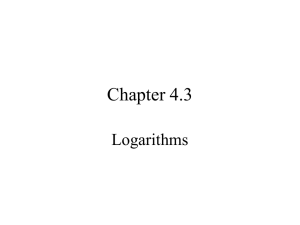Chapter 5
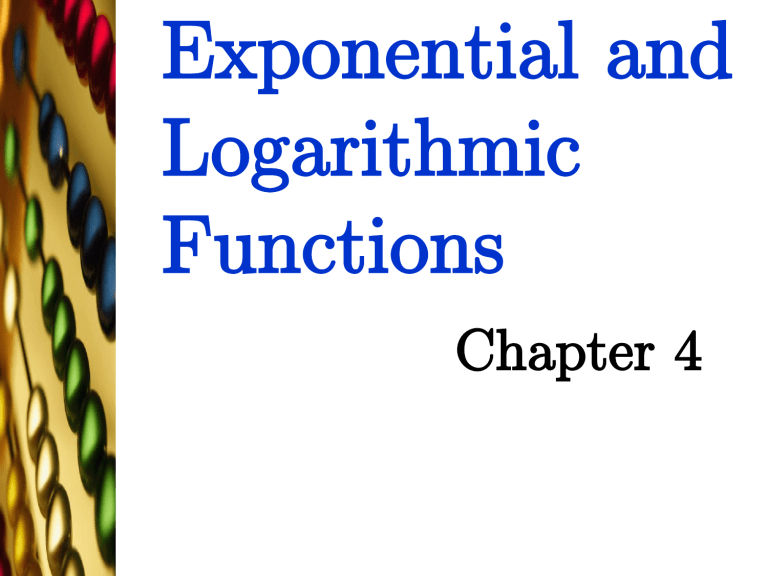
Exponential and
Logarithmic
Functions
Chapter 4
Composite
Functions
Section 4.1
Composite Functions
Construct new function from two given functions f and g
Composite function :
Denoted by f ° g
Read as “ f composed with g ”
Defined by
( f ° g )( x ) = f ( g ( x ))
Domain: The set of all numbers x in the domain of g such that g ( x ) is in the domain of f .
Composite Functions
Note that we perform the inside function g ( x ) first.
Composite Functions
Composite Functions
Example. Suppose that f ( x ) = x 3 { 2 and g ( x ) = 2 x 2 + 1. Find the values of the following expressions.
(a) Problem: ( f ± g )(1)
Answer:
(b) Problem: ( g ± f )(1)
Answer:
(c) Problem: ( f ± f )(0)
Answer:
Composite Functions
Example. Suppose that f ( x ) = 2 x 2 + 3 and g ( x ) = 4 x 3 + 1.
(a) Problem: Find f ± g .
Answer:
(b) Problem: Find the domain of f ± g .
Answer:
(c) Problem: Find g ± f .
Answer:
(d) Problem: Find the domain of f ± g .
Answer:
Composite Functions
Example. Suppose that f ( x ) = and g ( x ) =
(a) Problem: Find f ± g .
Answer:
(b) Problem: Find the domain of f ± g .
Answer:
(c) Problem: Find g ± f .
Answer:
(d) Problem: Find the domain of f ± g .
Answer:
Composite Functions
Example.
Problem: If f ( x ) = 4 x + 2 and g ( x ) = show that for all x ,
( f ± g )( x ) = ( g ± f )( x ) = x
Decomposing Composite
Functions
Example.
Problem: Find functions f and g such that f ± g = H if
Answer:
Key Points
Composite Functions
Decomposing Composite Functions
One-to-One
Functions;
Inverse Functions
Section 4.2
One-to-One Functions
One to one function: Any two different inputs in the domain correspond to two different outputs in the range.
If x
1 and x
2 function f are two different inputs of a
, then f ( x
1
)
f ( x
2
).
One-to-One Functions
One-to-one function
Not a one-to-one function
Not a function
One-to-One Functions
Example.
Problem: Is this function one-to-one?
Answer:
Person Salary
Melissa
John
Jennifer
Patrick
$45,000
$40,000
$50,000
One-to-One Functions
Example.
Problem: Is this function one-to-one?
Answer:
Person ID Number
Alex
Kim
Dana
Pat
1451678
1672969
2004783
1914935
One-to-One Functions
Example. Determine whether the following functions are one-to-one.
(a) Problem: f ( x ) = x 2 + 2
Answer:
(b) Problem: g ( x ) = x 3 { 5
Answer:
One-to-One Functions
Theorem.
A function that is increasing on an interval I is a one-to-one function on
I .
A function that is decreasing on an interval I is a one-to-one function on
I .
Horizontal-line Test
If every horizontal line intersects the graph of a function f in at most one point, then f is one-to-one.
Horizontal-line Test
Example.
Problem: Use the graph to determine whether the function is one-to-one.
Answer:
6
4
2
-6 -4 -2
-2
-4
-6
2 4 6
Horizontal-line Test
Example.
Problem: Use the graph to determine whether the function is one-to-one.
Answer:
6
4
2
-6 -4 -2
-2
-4
-6
2 4 6
Inverse Functions
Requires f to be a one-to-one function
The inverse function of f
Written f {1
Defined as the function which takes
f ( x ) as input
Returns the output x .
In other words, f {1 undoes the action of f
f {1 ( f ( x )) = x for all x in the domain of f
f ( f {1 ( x )) = x for all x in the domain of f {1
Inverse Functions
Example. Find the inverse of the function shown.
Problem:
Person ID Number
Alex
Kim
Dana
Pat
1451678
1672969
2004783
1914935
Inverse Functions
Example. (cont.)
Answer:
Person ID Number
1451678
1672969
2004783
1914935
Alex
Kim
Dana
Pat
Inverse Functions
Example.
Problem: Find the inverse of the function shown.
f (0, 0), (1, 1), (2, 4), (3, 9), (4, 16) g
Answer:
Domain and Range of
Inverse Functions
If f is one-to-one, its inverse is a function.
The domain of f {1 is the range of f .
The range of f {1 is the domain of f
Domain and Range of
Inverse Functions
Example.
Problem: Verify that the inverse of f ( x ) = 3 x { 1 is
Graphs of Inverse Functions
The graph of a function f and its inverse f {1 are symmetric with respect to the line y = x .
Graphs of Inverse Functions
Example.
Problem: Find the graph of the inverse function
6
Answer:
4
2
-6 -4 -2
-2
-4
-6
2 4 6
Finding Inverse Functions
If y = f ( x ),
Inverse if given implicitly by x = f ( y ).
Solve for y if possible to get y = f {1 ( x )
Process
Step 1: Interchange x and y to obtain an equation x = f ( y )
Step 2: If possible, solve for y in terms of x .
Step 3: Check the result.
Finding Inverse Functions
Example.
Problem: Find the inverse of the function
Answer:
Restricting the Domain
If a function is not one-to-one, we can often restrict its domain so that the new function is one-to-one.
Restricting the Domain
Example.
Problem: Find the inverse of if the domain of f is x ¸ 0.
Answer:
6
4
2
-6 -4 -2
-2
-4
-6
2 4 6
Key Points
One-to-One Functions
Horizontal-line Test
Inverse Functions
Domain and Range of Inverse
Functions
Graphs of Inverse Functions
Finding Inverse Functions
Restricting the Domain
Exponential
Functions
Section 4.3
Exponents
For negative exponents:
For fractional exponents:
Exponents
Example.
Problem: Approximate 3 ¼ to five decimal places.
Answer:
Laws of Exponents
Theorem. [Laws of Exponents]
If s , t , a and b are real numbers with a > 0 and b > 0, then
a s ¢ a t = a s + t
( a s ) t = a st
( ab ) s = a s ¢ b s
1 s = 1
a 0 = 1
Exponential Functions
Exponential function : function of the form
f ( x ) = a x where a is a positive real number ( a > 0) a
1.
Domain of f : Set of all real numbers.
Warning!
This is not the same as a power function.
(A function of the form f ( x ) = x n )
Exponential Functions
Theorem.
For an exponential function f ( x ) = a x , a > 0, a
1, if x is any real number, then
Graphing Exponential
Functions
Example.
Problem: Graph f ( x ) = 3 x
Answer:
6
4
2
2 4 6 -6 -4 -2
-2
-4
-6
Graphing Exponential
Functions
Properties of the
Exponential Function
Properties of f ( x ) = a x , a > 1
Domain: All real numbers
Range: Positive real numbers; (0, 1 )
Intercepts:
No x -intercepts
y -intercept of y = 1 x -axis is horizontal asymptote as x
{ 1
Increasing and one-to-one.
Smooth and continuous
Contains points (0,1), (1, a ) and
Properties of the
Exponential Function f ( x ) = a x , a > 1
Properties of the
Exponential Function
Properties of f ( x ) = a x , 0 < a < 1
Domain: All real numbers
Range: Positive real numbers; (0, 1 )
Intercepts:
No x -intercepts
y -intercept of y = 1 x -axis is horizontal asymptote as x
1
Decreasing and one-to-one.
Smooth and continuous
Contains points (0,1), (1, a ) and
Properties of the
Exponential Function f ( x ) = a x , 0 < a < 1
The Number e
Number e : the number that the expression approaches as n
1 .
Use e x or exp( x ) on your calculator.
The Number e
Estimating value of e
n = 1: 2
n = 2: 2.25
n = 5: 2.488 32
n = 10: 2.593 742 460 1
n = 100: 2.704 813 829 42
n = 1000: 2.716 923 932 24
n = 1,000,000,000: 2.718 281 827 10
n = 1,000,000,000,000: 2.718 281 828 46
Exponential Equations
If a u = a v , then u = v
Another way of saying that the function f ( x ) = a x is one-to-one.
Examples.
(a) Problem: Solve 2 3 x {1 = 32
Answer:
(b) Problem: Solve
Answer:
Key Points
Exponents
Laws of Exponents
Exponential Functions
Graphing Exponential Functions
Properties of the Exponential
Function
The Number e
Exponential Equations
Logarithmic
Functions
Section 4.4
Logarithmic Functions
Logarithmic function to the base a
a > 0 and a
1
Denoted by y = log a x
Read “ logarithm to the base a of x ” or
“ base a logarithm of x ”
Defined: y = log a x if and only if x = a y
Inverse function of y = a x
Domain: All positive numbers (0, 1 )
Logarithmic Functions
Examples. Evaluate the following logarithms
(a) Problem: log
7
49
Answer:
(b) Problem:
Answer:
(c) Problem:
Answer:
Logarithmic Functions
Examples. Change each exponential expression to an equivalent expression involving a logarithm
(a) Problem: 2 ¼ = s
Answer:
(b) Problem: e d = 13
Answer:
(c) Problem: a 5 = 33
Answer:
Logarithmic Functions
Examples. Change each logarithmic expression to an equivalent expression involving an exponent.
(a) Problem: log a
10 = 7
Answer:
(b) Problem: log e t = 4
Answer:
(c) Problem: log
5
17 = z
Answer:
Domain and Range of
Logarithmic Functions
Logarithmic function is inverse of the exponential function.
Domain of the logarithmic function
Same as range of the exponential function
All positive real numbers, (0, 1 )
Range of the logarithmic function
Same as domain of the exponential function
All real numbers, ({ 1 , 1 )
Domain and Range of
Logarithmic Functions
Examples. Find the domain of each function
(a) Problem: f ( x ) = log
9
(4 { x 2 )
Answer:
(b) Problem:
Answer:
Graphing Logarithmic
Functions
Example. Graph the function
Problem: f ( x ) = log
3 x
Answer:
6
4
2
2 4 6 -6 -4 -2
-2
-4
-6
Properties of the
Logarithmic Function
Properties of f ( x ) = log a
x , a > 1
Domain: Positive real numbers; (0, 1 )
Range: All real numbers
Intercepts:
x -intercept of x = 1
No y -intercepts
y -axis is horizontal asymptote
Increasing and one-to-one.
Smooth and continuous
Contains points (1,0), ( a , 1) and
Properties of the
Logarithmic Function
Properties of the
Logarithmic Function
Properties of f ( x ) = log a
x , 0 < a <
Domain: Positive real numbers; (0, 1 )
1
Range: All real numbers
Intercepts:
x -intercept of x = 1
No y -intercepts
y -axis is horizontal asymptote
Decreasing and one-to-one.
Smooth and continuous
Contains points (1,0), ( a , 1) and
Properties of the
Logarithmic Function
Special Logarithm Functions
Natural logarithm :
y = ln x if and only if x = e y
ln x = log e x
Common logarithm :
y = log x if and only if x = 10 y
log x = log
10 x
Special Logarithm Functions
Example. Graph the function
Problem: f ( x ) = ln (3{ x )
Answer: 6
4
2
-6 -4 -2
-2
-4
-6
2 4 6
Logarithmic Equations
Examples. Solve the logarithmic equations. Give exact answers.
(a) Problem: log
4 x = 3
Answer:
(b) Problem: log
6
( x {4) = 3
Answer:
(c) Problem: 2 + 4 ln x = 10
Answer:
Logarithmic Equations
Examples. Solve the exponential equations using logarithms. Give exact answers.
(a) Problem: 3 1+2 x = 243
Answer:
(b) Problem: e x +8 = 3
Answer:
Key Points
Logarithmic Functions
Domain and Range of Logarithmic
Functions
Graphing Logarithmic Functions
Properties of the Logarithmic
Function
Special Logarithm Functions
Logarithmic Equations
Properties of
Logarithms
Section 4.5
Properties of Logarithms
Theorem. [Properties of Logarithms]
For a > 0, a
1, and r some real number:
log a
1 = 0
log a a = 1
log a a r = r
Properties of Logarithms
Theorem. [Properties of Logarithms]
For M , N , a > 0, a
1, and r some real number:
log a
( MN ) = log a
M + log a
N
log a
M r = r log a
M
Properties of Logarithms
Examples. Evaluate the following expressions.
(a) Problem:
Answer:
(b) Problem: log
140
10 + log
140
14
Answer:
(c) Problem: 2 ln e 2.42
Answer:
Properties of Logarithms
Examples. Evaluate the following expressions if log log b
B = {4.
b
A = 5 and
(a) Problem: log b
AB
Answer:
(b) Problem:
Answer:
(c) Problem:
Answer:
Properties of Logarithms
Example. Write the following expression as a sum of logarithms.
Express all powers as factors.
Problem:
Answer:
Properties of Logarithms
Example. Write the following expression as a single logarithm.
Problem: log a q { log a r + 6 log a p
Answer:
Properties of Logarithms
Theorem. [Properties of Logarithms]
For M , N , a > 0, a
1,
If M
If log a
= N
M
, then log
= log a a
M = log a
N
N , then M = N
Comes from fact that exponential and logarithmic functions are inverses.
Logarithms with Bases
Other than e and 10
Example.
Problem: Approximate log
3 four decimal places
19 rounded to
Answer:
Logarithms with Bases
Other than e and 10
Theorem. [Change-of-Base Formula]
If a
1, b
1 and M are all positive real numbers, then
In particular,
Logarithms with Bases Other than e and 10
Examples. Approximate the following logarithms to four decimal places
(a) Problem: log
6.32
65.16
Answer:
(b) Problem:
Answer:
Key Points
Properties of Logarithms
Properties of Logarithms
Logarithms with Bases Other than e and 10
Logarithmic and
Exponential
Equations
Section 4.6
Solving Logarithmic Equations
Example.
Problem: Solve log
3 algebraically.
4 = 2 log
3 x
Answer:
Solving Logarithmic Equations
Example.
Problem: Solve log
3 graphically.
4 = 2 log
3 x
Answer:
Solving Logarithmic Equations
Example.
Problem: Solve log
2
( x +2) + log
2
(1{ x ) = 1 algebraically.
Answer:
Solving Logarithmic Equations
Example.
Problem: Solve log
2
( x +2) + log
2
(1{ x ) = 1 graphically.
Answer:
Solving Exponential Equations
Example.
Problem: Solve 9 x { 3 x { 6 = 0 algebraically.
Answer:
Solving Exponential Equations
Example.
Problem: Solve 9 x { 3 x { 6 = 0 graphically.
Answer:
Solving Exponential Equations
Example.
Problem: Solve 3 x = 7 algebraically. Give an exact answer, then approximate your answer to four decimal places.
Answer:
Solving Exponential Equations
Example.
Problem: Solve 3 x = 7 graphically.
Approximate your answer to four decimal places.
Answer:
Solving Exponential Equations
Example.
Problem: Solve 5 ¢ 2 x = 3 algebraically.
Give an exact answer, then approximate your answer to four decimal places.
Answer:
Solving Exponential Equations
Example.
Problem: Solve 5 ¢ 2 x = 3 graphically.
Approximate your answer to four decimal places.
Answer:
Solving Exponential Equations
Example.
Problem: Solve 2 x {1 = 5 2 x +3 algebraically.
Give an exact answer, then approximate your answer to four decimal places.
Answer:
Solving Exponential Equations
Example.
Problem: Solve e 2 x { x 2 = 3 graphically.
Approximate your answer to four decimal places.
Answer:
Key Points
Solving Logarithmic Equations
Solving Exponential Equations
Compound
Interest
Section 4.7
Simple Interest
Simple Interest Formula
Principal of P dollars borrowed for t years at per annum interest rate r
Interest is I = Prt
r must be expressed as decimal
Compound Interest
Payment period
Annually: Once per year
Semiannually: Twice per year
Quarterly: Four times per year
Monthly: 12 times per year
Daily: 365 times per year
Compound Interest
Theorem. [Compound Interest
Formula]
The amount A after t years due to a principal P invested at an annual interest rate r compounded n times per year is
Compound Interest
Example. Find the amount that results from the investment of $1000 at 8% after a period of 8 years.
(a) Problem: Compounded annually
Answer:
(b) Problem: Compounded quarterly
Answer:
(c) Problem: Compounded daily
Answer:
Compound Interest
Theorem. [Continuous Compounding]
The amount A after t years due to a principal P invested at an annual interest rate r compounded continuously is
Compound Interest
Example. Find the amount that results from the investment of $1000 at 8% after a period of 8 years.
Problem: Compounded continuously
Answer:
Effective Rates of Interest
Effective Rate of Interest :
Equivalent annual simple interest rate that yields same amount as compounding after 1 year.
Effective Rates of Interest
Example. Find the effective rate of interest on an investment at 8%
(a) Problem: Compounded monthly
Answer:
(a) Problem: Compounded daily
Answer:
(a) Problem: Compounded continuously
Answer:
Present Value
Present value : amount needed to invest now to receive A dollars at a specified future time.
Present Value
Theorem. [Present Value Formulas]
The present value P of A dollars to be received after t years, assuming a per annum interest rate r compounded n times per year, is if the interest is compounded continuously, then
Present Value
Example.
Problem: Find the present value of $5600 after 4 years at 10% compounded semiannually. Round to the nearest cent.
Answer:
Time to Double an Investment
Example.
Problem: What annual rate of interest is required to double an investment in 8 years?
Answer:
Key Points
Simple Interest
Compound Interest
Effective Rates of Interest
Present Value
Time to Double an Investment
Exponential Growth and
Decay;
Newton ’ s Law;
Logistic Growth and
Decay
Section 4.8
Uninhibited Growth and Decay
Uninhibited Growth:
No restriction to growth
Examples
Cell division (early in process)
Compound Interest
Uninhibited Decay
Examples
Radioactive decay
Compute half life
Uninhibited Growth and Decay
Uninhibited Growth:
N ( t ) = N
0
N
0
: initial population k : positive constant e kt , k > 0
t : time
Uninhibited Decay
A ( t ) = A
0
N
0
: initial amount k : negative constant e kt , k < 0
t : time
Uninhibited Growth and Decay
Example.
Problem: The size P of a small herbivore population at time t (in years) obeys the function P ( t ) = 600 e 0.24
t if they have enough food and the predator population stays constant. After how many years will the population reach 1800?
Answer:
Uninhibited Growth and Decay
Example.
Problem: The half-life of carbon 14 is 5600 years. A fossilized leaf contains 12% of its normal amount of carbon 14. How old is the fossil (to the nearest year)?
Answer:
Newton ’ s Law of Cooling
Temperature of a heated object decreases exponentially toward temperature of surrounding medium
Newton ’ s Law of Cooling
The temperature u of a heated object at a given time t can be modeled by u ( t ) = T + ( u
0
{ T ) e kt , k < 0 where T is the constant temperature of the surrounding medium, u
0 is the initial temperature of the heated object, and k is a negative constant.
Newton ’ s Law of Cooling
Example.
Problem: The temperature of a dead body that has been cooling in a room set at
70 ± F is measured as 88 ± F. One hour later, the body temperature is 87.5
± F.
How long (to the nearest hour) before the first measurement was the time of death, assuming that body temperature at the time of death was 98.6
± F?
Answer:
Logistic Model
Uninhibited growth is limited in actuality
Growth starts off like exponential, then levels off
This is logistic growth
Population approaches carrying capacity
Logistic Model
Logistic Model
In a logistic growth model, the population P after time t obeys the equation where a , b and c are constants with c > 0 ( c is the carrying capacity).
The model is a growth model if b > 0; the model is a decay model if b < 0.
Logistic Model
Logistic Model
Properties of Logistic Function
Domain is set of all real numbers
Range is interval (0, c )
Intercepts:
no x -intercept
y -intercept is P (0).
Increasing if b > 0, decreasing if b < 0
Inflection point when P ( t ) = 0.5
c
Graph is smooth and continuous
Logistic Model
Example. The logistic growth model represents the population of a species introduced into a new territory after t years.
(a) Problem: What was the initial population introduced?
Answer:
(b) Problem: When will the population reach 80?
Answer:
(c) Problem: What is the carrying capacity?
Answer:
Key Points
Uninhibited Growth and Decay
Newton ’ s Law of Cooling
Logistic Model
Building Exponential,
Logarithmic, and
Logistic Models from
Data
Section 4.9
Fitting an Exponential
Function to Data
Example. The population (in hundred thousands) for the
Colonial US in tenyear increments for the years 1700-1780 is given in the following table.
(Source: 1998
Information Please
Almanac)
Decade, x Population, P
0
1
251
332
4
5
2
3
6
7
8
466
629
906
1171
1594
2148
2780
Fitting an Exponential
Function to Data
Example. (cont.)
(a) Problem: State whether the data can be more accurately modeled using an exponential or logarithmic function.
Answer:
Fitting an Exponential
Function to Data
Example. (cont.)
(b) Problem: Find a model for population
(in hundred thousands) as a function of decades since 1700.
Answer:
Fitting a Logarithmic Function to Data
Year Rate of Death, r
Example. The death rate (in deaths per 100,000 population) for 20-
24 year olds in the
US between 1985-
1993 are given in the following table.
(Source: NCHS
Data Warehouse)
1985
1987
1989
1991
1992
134.9
154.7
162.9
174.5
182.2
Fitting a Logarithmic Function to Data
Example. (cont.)
(a) Problem: Find a model for death rate in terms of x , where x denotes the number of years since 1980.
Answer:
(b) Problem: Predict the year in which the death rate first exceeded 200.
Answer:
Fitting a Logistic Function to
Data
Example. A mechanic is testing the cooling system of a boat engine.
He measures the engine ’ s temperature over time.
Time t
(min.)
5
10
15
20
25
Temperature T
( ± F)
100
180
270
300
305
Fitting a Logistic Function to
Data
Example. (cont.)
(a) Problem: Find a model for the temperature T in terms of t , time in minutes.
Answer:
(b) Problem: What does the model imply will happen to the temperature as time passes?
Answer:
Key Points
Fitting an Exponential Function to
Data
Fitting a Logarithmic Function to
Data
Fitting a Logistic Function to Data

